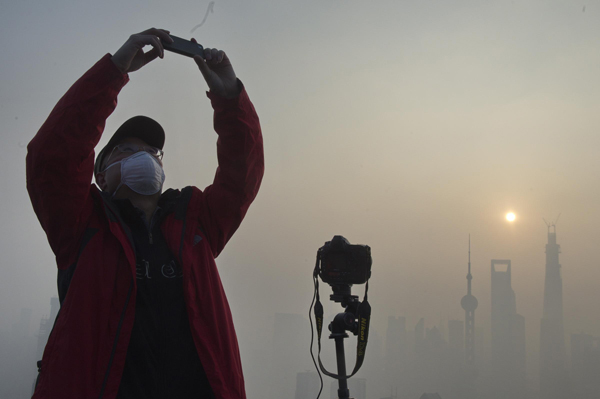 |
|
A resident in Shanghai takes a photo of the city's scenery amid heavy smog on Dec 7. [Photo/Xinhua] |
The smoggy weather affected a large swathe of the country's land from north to south, including Beijing, Hebei, Shandong, Jiangsu, Shanghai, Zhejiang, Hunan, Guangxi and Guangdong, with visibility less than 50 meters in some regions.
Cities like Shanghai and Nanjing have been enveloped in the grey sky for the past several days. Many pedestrians had to wear masks.
Beijing saw smog on Saturday. Local meteorological authorities forecast a cold front will reach Beijing on Sunday afternoon, which will quickly improve the air quality.
Meteorological authorities upgraded the warning level for thick fog to the highest red at 4 pm Saturday in Hebei Province. Visibility was less than 50 meters in some areas as the polluting weather hit several major cities like Shijiazhuang, the provincial capital, and Baoding. Many highways were closed.
In the Lukou airport in Nanjing, Jiangsu Province, more than 60 inbound and outbound flights were canceled on Saturday due to the smog, which also forced primary and middle schools and kindergartens to suspend classes on Thursday and Friday in the provincial capital.
At 6 pm Saturday, the National Meteorological Center (NMC) continued to issue an orange alert for haze, forecasting the polluting weather will linger in Jiangsu, Zhejiang, Shandong, Henan, Beijing and Tianjin in the next 24 hours starting from 8 pm Saturday.
China uses a four-tier warning system for extreme weather and air pollution, with red being the most serious, followed by orange, yellow and blue.
More than 100 entries to highways in east China's Shandong province were temporarily closed due to haze on Saturday, and some flights were canceled or delayed at the Jinan and Qingdao airports.
The Air Quality Index (AQI) topped 500 in certain areas of Shanghai on Friday. AQI of over 300 is defined as "serious pollution".
The prolonged smoggy weather began to affect north and east China on Monday.
He Lifu, chief meteorologist with the CMC, described this wave of haze in a meeting earlier this week as the severest so far this winter.
The Ministry of Environmental Protection said earlier this week that there were three major reasons behind the widespread haze: unfavorable weather conditions making it difficult for pollutants to diffuse, motor vehicle exhaust, and coal consumption for winter heating.
The ministry said that, thanks to a strong cold front, the air quality in north China and east China's Yangtze Delta area will significantly improve between Sunday and Wednesday next week.
In a plan unveiled in September, the Chinese government vowed to clean up the air by cutting coal use, closing polluters and promoting cleaner production. The plan aims to cut the density of inhalable particulate matter by at least 10 percent in major cities nationwide by 2017.
"We must face up to the realities," said Yan Naiqiang, a professor of environmental science at Shanghai Jiao Tong University. "The treatment of smog will be a long battle."
It is rather difficult for one single department to tackle air pollution, said Zhou Jun, an official of the Shanghai Environmental Protection Bureau.
|
|
|
|
|
|
|
|
